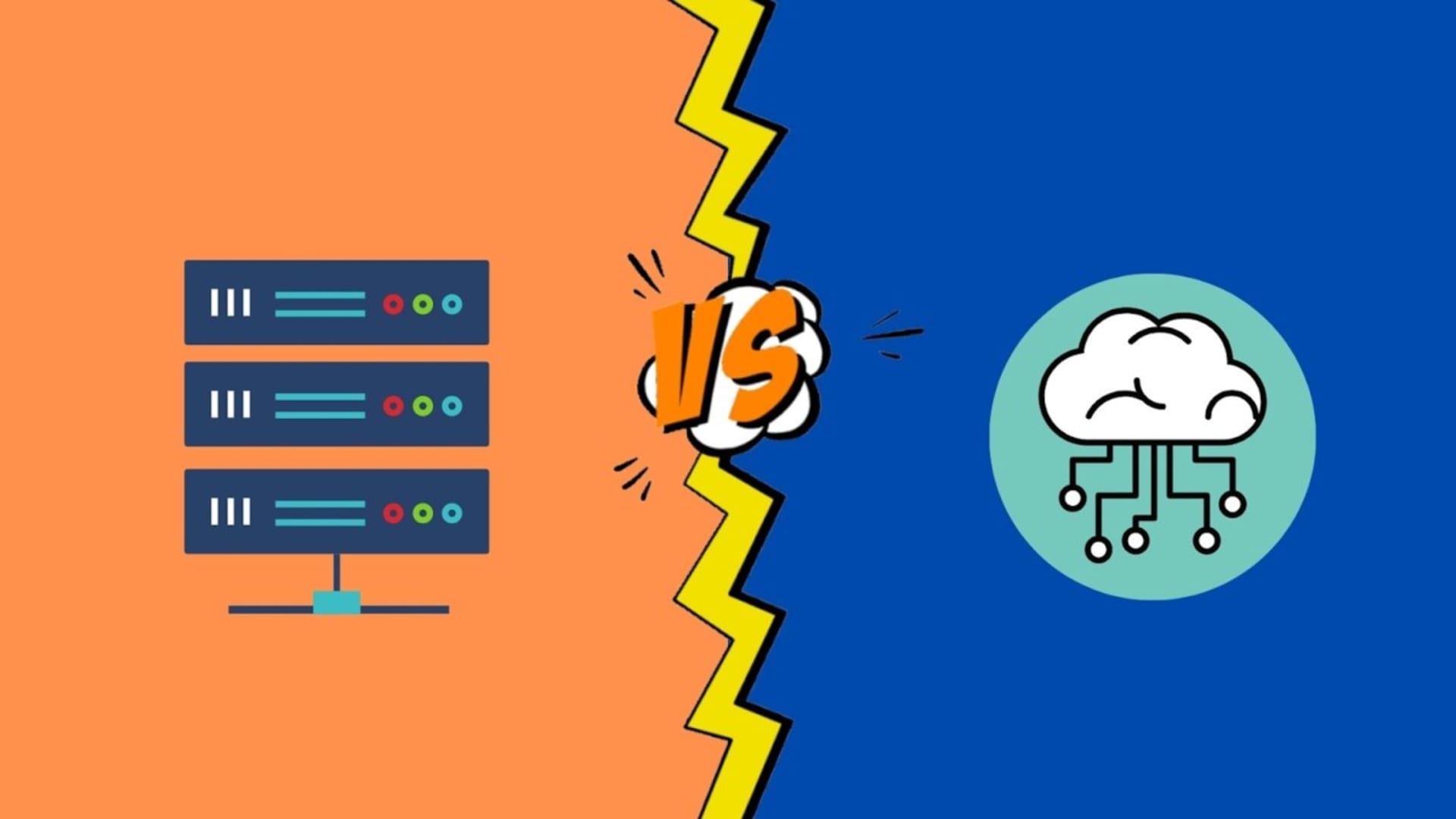In today’s digital landscape, businesses have multiple options when it comes to managing their computing infrastructure. Two popular choices are on-premises computing and cloud computing services. Each approach has its own set of advantages and considerations. In this article, we will explore the main differences along with benefits and risks associated with on-premises and cloud infrastructure solutions.
On-Premises Computing
On-premises computing refers to the practice of hosting and managing computer systems and applications within the physical premises of an organization. This means that all the server hardware and software along with the infrastructure required for computing operations are owned and maintained by the company itself.
On-premises solutions are commonly utilized by businesses that prioritize control with need-based customization and security. They are particularly prevalent in industries with strict data protection regulations on premise environments such as healthcare and finance. Organizations can tailor their systems to meet their needs as they have complete control.
Cloud Computing
Cloud computing on the other hand involves using IT infrastructure for the delivery of computing resources over the internet. Instead of relying on locally installed infrastructure, businesses leverage remote servers and services provided by third-party vendors. These services are accessed and managed through a web browser or specialized software applications.
At it’s core, cloud computing offers scalability and cost-effectiveness. By migrating to the cloud, companies can eliminate the need for upfront investments in hardware and infrastructure and they can benefit from the convenience of on-demand resource allocation and automatic software updates.
Main Differences: On-Premise vs Cloud
Whilst the future of cloud computing isn’t in doubt, on-premises solutions offer organizations unparalleled control and customization. This section explores the advantages of on-premises computing. Discover how on-premises solutions empower businesses with control over their infrastructure and the flexibility to meet their unique requirements.
Infrastructure
One of the primary distinctions between on-premises and cloud computing lies in key differences in the infrastructure setup. On-premises solutions require organizations to set up and maintain their own hardware and networking equipment within their premises. This involves significant upfront costs and ongoing maintenance responsibilities.
The cloud computing model on the other hand eliminates the need for organizations to manage their own physical infrastructure. The infrastructure is provided and maintained by the cloud environment provider. This allows businesses to focus on their core operations without the burden of infrastructure management.
Accessibility and Flexibility
When it comes to accessibility and flexibility cloud computing services hold a clear advantage. Cloud systems can be accessed from anywhere with an internet connection thereby enabling remote work and collaboration. This flexibility allows employees to work seamlessly across different locations and time zones thus promoting productivity and teamwork.
On-premises solutions have limitations in terms of remote access. They are primarily designed for on-site use and it becomes more challenging for employees to work remotely. While remote access solutions exist for on-premises setups, they often require additional configuration and may not provide the same level of convenience as cloud-based systems.
Costs
Cost considerations play a significant role in decision-making for businesses. On-premises computing typically involves higher upfront costs due to the need to purchase hardware, on-premise software licenses, and networking equipment. Additionally, there are ongoing expenses related to maintenance and upgrades.
Cloud computing offers a more cost-effective model for many organizations. Instead of large upfront investments businesses pay for cloud services on a subscription or pay-as-you-go basis. This allows for greater scalability and flexibility as resources can be easily scaled up or down based on demand. Cloud solutions also reduce the need for in-house IT staff which potentially leads to further cost savings.
Security
Security is a crucial aspect of any computing environment. On-premises solutions provide organizations with direct control over their data and infrastructure which allows them to implement specific security measures tailored to their needs. This level of control can be advantageous for industries handling sensitive information where compliance with data protection regulations is of utmost importance.
Cloud computing is generally secure but still requires organizations to trust their data and systems to third-party cloud providers. This reliance on external services raises concerns about data protection along with potential breaches and the level of control businesses have over their data. Cloud service providers invest heavily in security measures such as encryption and regular audits to ensure the protection of customer data.
Benefits of On-Premises Computing
Control and Customization
One of the significant advantages of on-premises computing is the level of control it offers. Organizations have complete authority over their infrastructure through which they can customize systems and software according to their specific requirements. This control allows for fine-tuning and optimization in industries where specific configurations are necessary.
Performance
In certain scenarios, on-premises systems can deliver superior performance compared to cloud applications. Since the infrastructure is located on-site, businesses can achieve low-latency connections and faster data processing. This advantage is especially relevant for applications that require real-time data processing or have stringent performance requirements.
Security and Compliance
For industries with strict security and compliance regulations on-premises computing provides a favorable option. By maintaining their infrastructure in-house businesses can implement stringent security measures and ensure compliance with industry standards and regulations. This level of control and oversight is crucial for organizations handling sensitive data or operating in highly regulated sectors.
Benefits of a Cloud Computing Environment
In today’s digital landscape businesses are increasingly turning to the cloud computing model for its numerous benefits. This section explores the advantages of a cloud computing environment and how it can empower organizations to optimize their operations and drive innovation.
Cost-Effectiveness
Cloud computing offers cost-effectiveness for businesses with budget constraints or unpredictable resource needs. Instead of upfront capital expenditures on hardware and infrastructure organizations can subscribe to cloud services on a flexible payment model. This approach minimizes upfront costs and allows businesses to scale resources up or down as needed by paying only for what they use.
Accessibility and Collaboration
The cloud enables seamless accessibility and collaboration. With cloud-based systems employees can access their work files and applications from any location with an internet connection. This flexibility empowers remote work which improves collaboration between teams and facilitates real-time sharing and editing of documents. Cloud solutions promote productivity and efficiency by enabling employees to work together regardless of their physical location.
Easy Upgrades and Maintenance
Cloud service providers handle the responsibility of system upgrades, relieving businesses of the burdens of maintenance costs. With automatic updates, organizations can benefit from the latest features, security patches, and bug fixes without the need for manual intervention. This convenience frees up in-house IT staff to focus on strategic initiatives rather than routine maintenance tasks.
Risks and Drawbacks
While both on-premises and cloud computing offer distinct benefits it’s essential to acknowledge the risks and drawbacks associated with each approach. In this section we delve into the potential challenges organizations may encounter when adopting on-premises or hybrid cloud solutions. By understanding these risks businesses can make informed decisions that align with their unique needs and circumstances.
Risks in On-Premises Computing
On-premises computing comes with its own set of risks and drawbacks. Firstly, there are significant upfront costs associated with purchasing and setting up the required infrastructure. Additionally, ongoing maintenance along with upgrades and repairs contribute to the total cost of ownership. Organizations also need to invest in skilled IT staff capable of managing and troubleshooting the on-premises systems. There can be potential downtime during system upgrades or maintenance which can lead to an impact on business operations.
Risks in Cloud Computing
Cloud computing is not without its risks. Dependence on the internet connection is a primary concern for businesses relying on cloud solutions. A loss of internet connectivity can disrupt access to critical applications and data. Another risk is the possibility of vendor lock-in where businesses become heavily reliant on a specific cloud software or service provider which makes it challenging to switch to alternative solutions. Additionally, the perceived loss of control over data security and privacy remains a concern for some organizations when dealing with highly sensitive information.
Choosing Between On-Premises and a Cloud Environment
In this section, we will explore the key considerations that should be kept into account while making a decision to choose either on-premises or cloud computing.
Considerations
- Company Size: The size of the organization can influence the feasibility of on-premises versus cloud solutions. Smaller businesses may find it more cost-effective to leverage cloud services whereas larger enterprises might have the resources to invest in on-premises infrastructure.
- Industry: Different industries have varying compliance requirements and data sensitivity. Businesses operating in highly regulated sectors may prioritize the control and security offered by on-premises solutions.
- Budget: Financial considerations play a significant role. On-premises solutions involve higher upfront costs, whereas cloud computing provides more flexibility in terms of subscription-based pricing models.
- IT Staff Capabilities: The expertise and capabilities of the in-house IT staff should be evaluated. On-premises solutions require skilled IT professionals to manage and maintain the infrastructure while cloud solutions rely on the expertise of the cloud service provider.
- Specific Business Needs: Businesses should assess their unique requirements, such as scalability, collaboration, and security. Evaluating these needs will help determine which solution aligns best with the organization’s goals.
Recommendations
When considering the choice between on-premises and cloud computing, it is important to evaluate individual circumstances. Here are some detailed recommendations based on different business scenarios.
- Startups and Small Businesses: Cloud computing proves to be an advantageous option for startups and small businesses. Its cost-effectiveness and ease of implementation make it an ideal choice for organizations operating with limited resources and requiring flexibility to adapt to changing demands.
- Medium to Large Enterprises: Larger organizations are equipped with substantial budgets and specific security and compliance needs therefore they often opt for on-premises solutions. The control and customization offered by on-premises computing cater to the intricate requirements of industries dealing with sensitive data thereby enabling them to adhere to strict regulations.
- Hybrid Approaches: In certain cases a hybrid approach that combines elements of both on-premises and cloud computing can be beneficial. This approach allows businesses to maintain critical data on-premises thereby ensuring direct control and security while leveraging the scalability and collaboration features of the cloud for less sensitive operations. It offers a balance between control and flexibility therefore accommodating diverse business needs.
By carefully considering these recommendations in light of their unique circumstances businesses can make informed decisions that align with their goals and specific requirements.
Conclusion
Choosing between on-premises and cloud computing requires a thorough assessment of factors such as infrastructure requirements with accessibility and business needs. While on-premises solutions offer control with customization and potentially better performance whereas cloud computing provides cost-effectiveness and collaboration advantages. Businesses must evaluate their unique circumstances and consider the benefits and risks of each approach before making an informed decision that aligns with their goals and objectives.
FAQs
What is the main difference between on-premises and cloud?
The main difference on-premises and cloud lies in the infrastructure setup and ownership. On-premises computing involves hosting and managing systems within the organization’s physical premises whereas cloud computing relies on remote servers and services provided by a third-party provider accessed over the internet.
Are on-premises solutions more secure than cloud solutions?
Security considerations depend on various factors. On-premises solutions offer organizations direct control over their infrastructure and data that allows them to implement specific physical and cybersecurity measures. Cloud solutions rely on external service providers’ security measures which can be robust but require trust in their capabilities.
Which is more cost-effective: on-premises or cloud computing?
The cost-effectiveness depends on the organization’s specific circumstances and requirements. On-premises computing typically incurs higher upfront costs while cloud computing offers a subscription-based model that allows businesses to scale resources as needed. Careful evaluation of upfront costs and scalability needs will help determine the most cost-effective solution for each organization’s premises.






